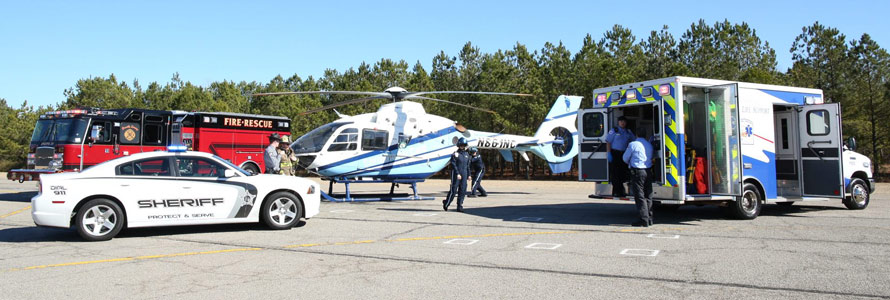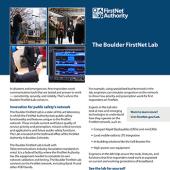Summary
In the latest episode of Public Safety First, Dave Buchanan chats with Captain Craig Schwartz of the Santa Rosa Police Department about how drones can help law enforcement with better situational awareness to make well-informed, mission-critical decisions.
Guest
Dave Buchanan
FirstNet Authority Executive Director of Public Safety Advocacy
Captain Craig Schwartz
Santa Rosa (CA) Police Department
Transcript
Preview
Narrator: You're listening to Public Safety First – a podcast to help you learn about the First Responder Network Authority and how you can be part of the future of public safety technology. And now, your host, Dave Buchanan.
Narrator: You're listening to Public Safety First – a podcast to help you learn about the First Responder Network Authority and how you can be part of the future of public safety technology. And now, your host, Dave Buchanan.
Dave Buchanan: Welcome to the Public Safety First podcast. We’re here in Orlando, Florida at the International Association of Chiefs of Police conference where the First Responder Network Authority team has had a series of terrific engagements and meetings. We’ve been involved in a number of panels, where we discussed the benefits of FirstNet, the use of data in law enforcement settings. We’ve been involved in a number of committee meetings where we’ve been able to talk about the value proposition and our engagement program going forward. We’ve also had the opportunity to meet with individual law enforcement executives – those that have traveled here to learn more at the International Association of Chiefs of Police Conference, and I’m joined today by Captain Craig Schwartz of the Santa Rosa Police Department. Welcome to the podcast, Craig!
Craig Schwartz: Thanks very much, happy to be here!
Dave Buchanan: Craig’s just started a new drone program for his police department and we’re going to talk a little bit about that today. He was just appointed to the aviation committee at IACP and we’re going to talk about that. But Craig, as we get started, can you tell us a little about your background? How’d you get into policing, and how’d you wind up as the leader of the new drone program?
Craig Schwartz: Sure. I honestly kind of fell into this job. I –my whole life desire, I just wanted to be a fighter pilot and fly jets, and went to the Naval Academy and graduated from there. Ended up in flight school being, coming down with an illness that precluded me from continuing with the Navy, and was suddenly left with no real backup plan. Got into law enforcement in my hometown where I grew up and just fit well. I really loved it as a career, loved the people I was working with, and have been there for the last 26 years, working my way up through the ranks. I got into – I’ve always been an aviation guy and very enthusiastic about it. I fly as a private pilot and have also always been interested in innovative technologies and how they can aid us in our public safety mission. When I started seeing, even just the hobbiest drones that are being flown around now by people in the community, I saw that as a device and a tool that could have a lot of utility for law enforcement and for public safety. And through a master’s program I was in, did some research on how law enforcement can not only use the unmanned aircraft technology but how they can implement the program while earning their community’s trust for them.
Dave Buchanan: So let’s talk about that a little bit. Earlier we were discussing, hey I’m fascinated by drones as well, and but really curious to hear you describe some of the law enforcement use cases associated with drones. I mean everyone sort of knows what they are and has seen them here and there, but how are you using it and can you describe the benefits you’ve already seen from your drone program?
Craig Schwartz: You know I think really, the utility of drones in law enforcement in particular is a field that is just starting to open up. Really almost anything that you could use a police helicopter for, I think you will eventually be able to use a drone for, with the exception, perhaps, of rescues where you’re actually trying to lift somebody out of a hazardous situation. You know, we –I envision them initially using them for search and rescue, looking for missing persons, on perimeter searches where you may have a criminal suspect whose fled from law enforcement, and is now hiding in the backyard or within a perimeter that officers have set on the ground, for tactical scenarios, either both inside and outside to give an aerial view and provide a better perspective, and allow law enforcement leaders the information they need to make better decisions.
Dave Buchanan: So, describe in a little more detail if you could, the drone obviously has a pilot, the drone in that scenario is going to have a camera, is there – what kind of personnel does it take to operate the drone in that setting where you want to use it to give additional situational awareness or additional visibility to the – your law enforcement agency. How many people are involved and what’s that like?
Craig Schwartz: Sure. At a minimum, you’re going to need a pilot – the remote pilot – and a visual observer. You have to keep the drone within line of sight to comply with the law right now, so you’re going to need somebody who’s got eyeballs looking at the device the entire time it’s in the air and then the pilot who will be also focusing attention on the screen and the view that they’re seeing from the drone’s camera. You may, depending on the situation, need another person on the ground just to keep an eye on the pilot and the visual observer, but there have been times where agencies have been using drones to say follow a fleeing suspect and the drone operator, drone pilot is looking at the screen saying, ‘okay well he’s going down the street and he’s going by the –oh wait, that’s me!’ and the guy runs right by him. And so, you really need to keep situational awareness on the ground as well. And then really depends on you know, what level of scenario you’re dealing with, but the ability to transmit the data from the drone to a larger screen where you could have an incident commander or tactical commander, or to just officers in the field, to give them that better situational awareness would really help out too.
Dave Buchanan: And that’s an exciting aspect that FirstNet could bring to this scenario you just described – is the ability to send that signal and those images and those video to any law enforcement personnel that needs that, at your discretion, be able to have the ability to do that I think could be really powerful.
Craig Schwartz: Exactly. Right now for ours, we’re just getting our program started. So when we are getting the downlink from the drone’s camera to the controller that we have out in the field, it’s over just the WiFi system from the drone to the controller or iPad that you have, and it operates over a pretty short distance and is limited in how far or how many people you can transmit that to. So, having the ability to use a different network to securely downlink that video or those photographs to multiple users in the field over a wider distance would be a huge benefit to all public safety.
Dave Buchanan: Talk a little bit about, if you would, the training involved for your pilot, for your visual observers, what was that like? How long did it take? And how many people in your agency have been trained and are able to operate and be a part of the drone program?
Craig Schwartz: Sure. Well, for our program, we have decided that all of our remote pilots will need to be FAA certified through Part 107 of the new regulations that the federal government has adopted. So, everybody will have to go through it and get their remote pilot certificate from the FAA. Additionally, we will provide monthly or quarterly training to deal with you know, law enforcement-specific issues, scenarios. And find there are more and more schools and courses coming available to train law enforcement operators – public safety operators really – on things like how to fly and operate them during hours of darkness, how to use the infrared systems that are available, how to fly them say indoors. They’d be very useful I think for some tactical scenarios involving SWAT teams, or high-risk searches of buildings, potentially active shooter scenarios where you could very rapidly and safely search an area, even an area inside a building, with a drone rather than having to send officers into harm’s way first.
Dave Buchanan: How hard was it to convince your leadership that you should invest in a drone program?
Craig Schwartz: You know, it was the, I think the most critical part of the process, convincing the city leadership and also the community, that this is something that will benefit the community and that we will use responsibly and constitutionally. My master’s research was on the topic of how to implement a drone program while earning the community’s trust for the use of a controversial technology. In my research, I really looked heavily at the IACP’s recommendations on how to implement a program like that and used case studies to test whether those recommendations were effective. And what I found was that, yeah, if you do it right, if you are transparent with your community, and talk about the benefits and talk about some of the potential misuse of them, and gather community feedback, and feedback from your elected leaders on how they would like these things to be used and what protections or controls should be in place to prevent any privacy violations, for example. Then, it’s an easier way to do it and you’re far more likely to win your community’s trust for it. As we see more and more of the agencies using these things now, it’s going to be to the point where I think eventually people will just going to get used to seeing them in public safety and in law enforcement.
Dave Buchanan: So give us a recent example of how you’ve put the drone program to use and what was the outcome of that event?
Craig Schwartz: Sure. You know, I can think of two great operational examples – one that we had with our program and one that helped us get our program up and running. First, a year ago today, was the wildfire, the Tubbs fire that burned through my city, and destroyed in that fire, over 5,200 homes in basically one night, 3,000 inside the city limits. In the wake of that, a number of agencies like the Alameda County Sheriff’s Office came up and were flying drones in support of my city and doing aerial mapping, and providing better situational awareness, and helping with the recovery efforts after the fire. That I was able to use to show the community how these things can really benefit us. When we got ours up and running, our first mission – our second mission actually – was in support of our fire department. There was a liquid oxygen tanker truck that was trying to refill tanks at Kaiser Hospital in Santa Rosa and during that transfer process, there was a large explosion that injured the driver, and blew debris all over the place, and was still leaking liquid oxygen right next to the freeway and shutdown north and southbound Highway 101 at rush hour. And we used the drone in support of the fire department and got an aerial view to provide their command post with an eyeball on what was happening and we were able to get that resolved more quickly and safely for the firefighters, everybody at the hospital, and get the traffic open up on the freeway much faster.
Dave Buchanan: So, we’re here at IACP, you’re part of the aviation committee, what are the issues that you’re trying to tackle on the aviation committee?
Craig Schwartz: It’s my first meeting with the committee, so I’m kind of waiting to see. I know that they’ve been focused heavily on unmanned aircraft though and I expect they will continue to be.
Dave Buchanan: Well this has been great, Craig. I really appreciate your time today. Appreciate you sharing the details of the drone program at the Santa Rosa Police Department. Glad I got a chance to meet you and best wishes with the rest of the conference.
Craig Schwartz: Oh, thank you very much and thanks for having me. I appreciated the opportunity.
Narrator: Thanks for listening today. We're excited to have you join our podcast community. Make sure to subscribe on iTunes, SoundCloud, and YouTube. You can learn more about the First Responder Network Authority at FirstNet.gov and learn about FirstNet products and services at FirstNet.com





















